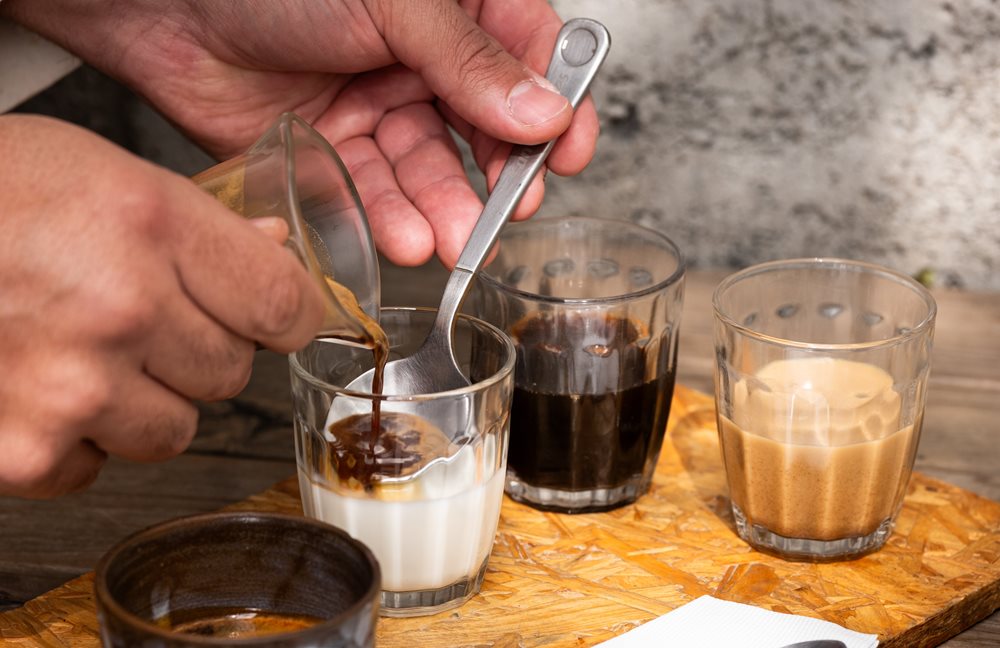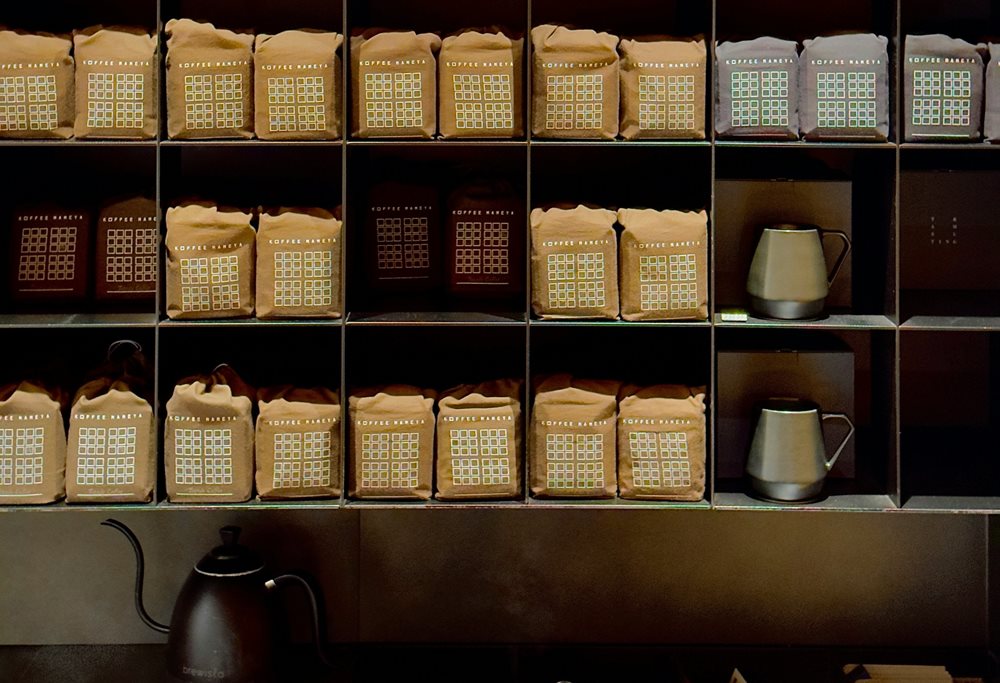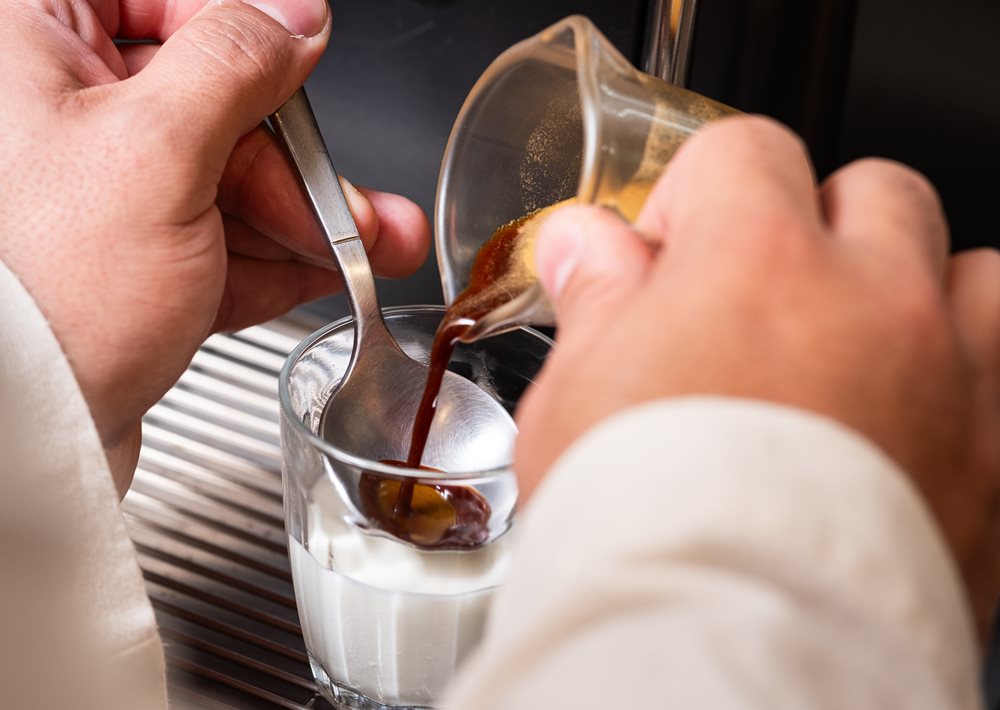Once the preserve of Japan’s finest sushi restaurants, highly curated
omakase experiences are now offered by a growing number of specialty coffee shops.
Espresso magazine’s Letícia Souza speaks to the venues taking their customers on a sensory journey to discover some of the world’s rarest coffees while pushing the boundaries of mixology, craft and quality

Coffee omakase at Pato Rei in São Paulo, Brazil | Photo credit: Agência Ophelia
Imagine sitting at a coffee shop counter and being served rare coffees paired with exquisite food and curated by the world’s finest baristas and craftspeople. Coffee
omakase is a unique super-premium experience where customers sit back, relax and are guided through a sensory journey by a barista without ever having to glance at a menu.
The concept of
omakase, which means ‘I leave it up to you’ in Japanese, originated in high-end sushi restaurants, where chefs would offer a curated selection of seasonal dishes made with ingredients available on the day. Such is the regard for
omakase in the fine dining world, ‘few formal dining experiences are as revered or as intimidating’, according to the Michelin Guide.
However, during the pandemic a small number of Japanese specialty coffee shops and roasters also began offering
omakase experiences to showcase exclusive coffees to individuals or small groups.
One of the first was Koffee Mameya, which opened in 2011 in a former book warehouse in Tokyo’s Kiyosumi-Shirakawa district. Today, the boutique specialty coffee shop also operates a venue in the city’s upmarket Omotesando neighbourhood and has expanded internationally to Hong Kong.
“We started
omakase in 2021 after years of building relationships with our customers, suppliers and roasters,” says owner, Eiichi Kunitomo. “The aim was to show that specialty coffee shops can offer the same kind of fine dining experiences enjoyed in restaurants,” he adds.
“Specialty coffee shops can now offer the same kind of fine dining experiences enjoyed in restaurants”
Eiichi Kunitomo, owner, Koffee Mameya
The trend has since boomed in Japan and today is gaining traction internationally as far afield as Europe, the US and Brazil.
In coffee shops,
omakase is served in a variety of ways. There are venues that infuse different parts of the coffee plant – such as the leaves or dehydrated cherries – into cocktail-like creations complemented with a food pairing menu. There are also those that source exclusive and award-winning micro-batches to showcase coffees with diverse and rare sensory profiles.
Crucially, aside from the expectation of a super-premium experience, customers opting for
omakase coffee service are always in for a surprise, and at most, baristas in Japan will ask customers if they have any allergies.
Koffee Mameya doesn’t roast coffee in-house, but instead carefully curates small and micro batches from around the world. “We want our baristas to focus on their role as storytellers and expert coffee makers,” he explains. “This way, we connect our customers with producers and roasters.”
To showcase these skills, Koffee Mameya baristas present their coffee creations as if they were on a competition stage. “Instead of judges there are customers, and they often tip generously,” explains Kunitomo.

Packaged specialty coffee on display at Koffee Mameya in Tokyo, Japan | Photo credit: Antonio Fadel
As is common in Japan, reservations are required for Mameya Kakeru’s coffee
omakase experiences. Around two dozen menu options also change daily, ranging from super-premium nano-lots to cold brew and milk brew, which is made by steeping coffee grounds in milk rather than water.
In Tokyo, there is now an established market for ‘fine dining’ coffee experiences but the coffee omakase trend can now also be found in Brazil’s coffee capital, São Paulo.
São Paulo’s Pato Rei specialises in rare geshas and offers a daily coffee omakase, which co-owner Tiago de Mello calls omakafé. “Our space is for experimentation, it’s where we make our art,” explains Mello, a master roaster who is also a musician. The geshas, renowned for their floral notes and delicate flavour, are produced by Luiz Paulo Pereira on Carmo Coffee’s Santuário Sul farm in Minas Gerais, Brazil, and roasted in-house by Mello.
It’s up to you
In Japan, some coffee shops offer omakase to a handful of customers per day, while others operate more like private clubs and will even keep their location secret until a reservation is confirmed.
In these high-end and exclusive coffee shops, every detail matters. Guests can expect to be greeted by elegant interiors and baristas neatly dressed in uniforms or even more elaborate outfits, such as lab coats or overalls. However, the focus is always strictly on the coffee.
One such exclusive venue is Cokuun, located in Omotesando, Tokyo, where guests are required to make a reservation and pay around 16,500 yen (about $120) per person in advance. Cokuun’s coffee
omakase features beverages served in four stages as part of a menu that includes seasonal ingredients and pastry pairings.
The experience is guided by Hidenori Izaki, a 2014 world barista champion and owner of the Honey Coffee micro-roastery in Fukuoka, who is assisted by Miki Suzuki, a three-time Japanese barista champion and 2017 world finalist. “Cokuun has repositioned coffee as an ingredient,” the business’ website states, and only four guests are allowed per night for the experience.
“Coffee omakase is an opportunity for baristas to think outside the box”
Nathan Coffey, owner, Café Mezzanotte
In São Paulo, Catarina Coffee and Love offers an omakase service at weekends but takes a more informal approach. The boutique specialty coffee shop and micro-roastery’s head barista Enrique Ortiz guides guests through a secret tasting menu on low chairs arranged outside the venue.
Nevertheless, the coffee-tasting menu remains on par with a haute cuisine dining experience. “We always experiment through study and research,” says Ortiz, who also draws inspiration from trends in world championships. “More widely available coffees feature on our fixed menu, while rarer micro lots are reserved for the tasting menu,” he explains.
The tasting menu also always has a theme. “It varies according to the season and the ingredients we are focused on at the time.” For example, the espresso-based la cabra is made with vanilla syrup and goat’s milk. Also offered on the tasting menu is cold brew XO, which is flavoured with oak chips and cocoa nibs.

Pato Rei’s ‘dirty espresso’ | Photo credit: Agência Ophelia
Crossing the Pacific
The
omakase trend is also breaking ground in Miami Beach, USA, where Nathan Coffey, a barista, mixologist and anthropologist, offers customers at Café Mezzanotte what he says is the only coffee
omakase in the city. “People tell me they thought about doing the service, but never went ahead with it,” Coffey explains.
The first tastings Coffey offered at Mezzanotte featured coffees from around the globe brewed as both classic and innovative beverages. However, influenced by a friend from Osaka, Japan, he became interested in coffee omakase and decided to apply it locally. “The service requires a lot of research, time to study and availability to create new recipes,” he explains.
“Our space is for experimentation, it’s where we make our art”
Tiago de Mello, co-owner, Pato Rei
With this new universe of possibilities, Coffey realised that flavours and techniques could be explored in far greater detail and with a personalised approach – a far cry from Miami’s sprawling quick-service coffee chain market. “Intimacy with the customer is the spirit of
omakase,” Coffey says.
Although the curated experience differs every time, it always follows the same rules. The first is that the coffee must be sourced from roasters in Miami to promote local trade. The second is to always use single-origin beans. “Coffee
omakase is an opportunity for baristas to think outside the box and create drinks that are unique,” says Coffey. For him, gathering strangers around a table to enjoy the experience together is a crucial social element of the service. “Curating an experience like this explores the roots of coffee and encourages people to connect,” he says.
Coffee Omasake experiences
The omakafé experience
Pato Rei’s omakafé begins with the ‘supersayadeuso’ espresso (hello Dragon Ball fans), which has notes of white flowers and citrus acidity reminiscent of Bahia orange and the sweetness of Formosa papaya. All drinks on the menu are short (around 60 ml), so as not to make participants uncomfortable due to excess caffeine.
This is followed by a dirty espresso made with distilled milk (frozen to separate the fat from the water in the milk, making it more concentrated) and a shot of hot gesha espresso. The hosts suggest taking a sip without mixing it, which offers a delicious surprise in the mouth. The milk, with a velvety and buttery texture, is embraced by the hot, acidic and fruity espresso. ‘It’s a bucketful of drink’, as the Pato Rei baristas say.
How about trying a gesha cold brew? The third beverage, refreshing and intense is extracted for four hours with hot water added after. To close the menu, a drink that is trending in Asia: milk brew (a cold extraction technique similar to cold brew replacing water with milk or plant-based alternative). Here, the gesha beans are infused in oat milk for 18 hours. In the mouth, the creamy and delicate drink resembles iced chocolate – perfect for hot days.
Catarina Coffee’s creations
Catarina’s secret menu typically includes two creations. Arecent example is la cabra, a hot coffee reminiscent of the classic cortado with goat’s milk, vanilla syrup from Brazil’s Cerrado region and smoked salt. The goat’s milk is intense and provides a smooth balance between fat and acidity when it hits the espresso. Top it off with salt and syrup and the sensation is like drinking a buttery biscuit. Another of Catarina’s creations is the motchango – matcha and plant-based milk served cold with tapioca pearls and strawberry syrup.
Catarina’s tasting menu includes two beverages and a dessert. It starts with the cold brew XO, which is flavoured with oak chips, cocoa nibs and priprioca root. To create it, the baristas thought about what it would be like to age a cold brew (made from 70% canephora and 30% arabica) in oak barrels.
To prevent the beverage from spoiling, the production process is sped up with sonic vibration equipment typically used in chemistry laboratories. In the cup, the sensation is that of drinking an iced coffee with intense notes of spice and the aftertaste of a good cigar.
The second beverage is a fat-washed filter coffee made with an infusion of pumpkin seed oil and filtered twice. The contact of the coffee with the fat changes its texture, making it fuller-bodied and more aromatic.
For dessert, não é cartola is made with buriti fruit candy and a light sour cream of chestnuts, coffee syrup and puxuri – just the right mix of sweet, sticky and sour.
Rare Latin coffees
Nestled in Tokyo’s Kuramae neighbourhood, Lonich describes itself as ‘no ordinary coffee shop’, and reservations are strictly required. Attracting coffee lovers from Tokyo and all over the world, Lonich has offered a curated range of rare coffees from countries such as Yemen, Colombia, Panama, Guatemala and Peru, since 2022.
In addition to its extensive coffee menu and a subscription club, the coffee shop has three types of service. Seasonal omakase delivers a selection of coffees paired with sweets made according to seasonal ingredients. The venue also provides a Japanese-Chinese fusion of tea and coffee beverages made using ingredients from both countries. The ‘gesha collective’ offers guests a selection of rare coffees from across Latin America.
This article was first published in Portuguese in Espresso magazine and republished in Issue 22 of 5THWAVE magazine.
Subscribe to 5THWAVE to receive each edition in print and digitally or sign up to our newsletter and be the first to read the latest articles and updates on World Coffee Portal research.
